-
In the
IAL 3: The Moon: Orbit, Phases, Eclipses, and More,
we considered the Moon as an
astronomical object in the sense of
old astronomy:
an astronomical object
to be watched on the sky: e.g.,
see the figure below/above
(local link /
general link: moon/afar/moon_stars.html).
We now consider the Moon as a physical body---we consider
its nature,
geology, origins, and fate.
As a preview/review, see Moon videos below (local link / general link: moon_videos.html):
-
Just some basic Moon facts---which, of course, beg for an explanation---and
there is some explanation, but also some
"just so stories"---"just so stories"
for us that is---somebody has thought of everything, I'd guess.
- Basic Moon Facts:
First let's look at a table of Moon facts.
Remember you look at tables NOT to try to memorize the numbers, but to contemplate what they mean while you look at them.
________________________________________________________________________________________________________ Moon Facts ________________________________________________________________________________________________________ Quantity Value ________________________________________________________________________________________________________ Mean distance from Earth 384,400 km = 60.2684 R_Earth_equatorial Center-to-center distance as almost always in astronomy since that is the relevant distance for the graviational force and center-of-mass motion and inertial frames. Eccentricity of orbit 0.0549 Mean inclination to Ecliptic 5.145396 degrees Mean orbital period 27.32166 days Lunar Month 29.53059 days: this is also the lunar day Equatorial radius 1737.4 km = 0.2725 R_Earth_equatorial Mass 7.3483*10**22 kg = 1/81.3 Earth masses. Volume and therefore mass tend to scale as the radius to power 3. Since the Moon diameter is about 1/4 of the Earth diameter, one would guess its mass would be (1/4)**3=1/64 of the Earth's mass. The actual is small still since the Moon density is less than the Earth density. Mean density 3.36 g/cm**3 = about 3/5 Mean Earth density. This is a clue: it's much smaller than even uncompressed iron density 7.874 g/cm**3. The Moon must have relatively less iron. Equatorial surface gravity 0.1654 Earth gravities ≅ 1/6 Earth gravities. The Moon mass is 1/81.3 of the Earth's mass, but the Moon's gravity is NOT reduced by the same factor, because the Moon's radius is also smaller. Mass and radius are both parameters of surface gravity. The lower gravity is actually vital for astronauts on the Moon since the massive space suits they wear and heavy moving of equipment they do would be impossible without it. Surface temperature -170 C at night to 130 C in the day. The lack of an atmosphere and oceans (which store heat energy and insulate against heat flows) cause the surface temperature to change rapidly between extremes with heating by absorbing visible light by day and cooling by emitting IR by night. The Moon has a low thermal inertia: i.e., a low resistance to temperature change. The daytime and nighttime periods of about two weeks are also a factor. The astronauts on the Moon needed to be protected by their space suits from hot surfaces, but NOT hot air since their is none. ________________________________________________________________________________________________________ References: Cox-16,303,305; Se-445. ________________________________________________________________________________________________________
Now how does the Moon rank in the Solar System?
Though much smaller than the Earth, the Moon still ranks high among the rocky/icy bodies in the Solar System---it's number 9---see the figure below (local link / general link: rocky_icy_body.html).
- Selenography:
The Moon has geography, of course---with special-case name selenography.
- First, let's look at an image
moon map
of the near side of the Moon
in figure below
(local link /
general link: moon_map_side_near.html).
- Second, let's look a topographic map of the near side of the Moon in the figure below. (local link / general link: moon_map_side_near_topographic.html).
- We've elucidated many aspects of the Moon by going there robotically and in person (see Wikipedia: Exploration of the Moon).
The third moon map of near side of the Moon we will look at (see the figure below local link / general link: moon_map_side_near_exploration.html) is an exploration map that illustrates our "invasion"---the Selenites havn't even noticed.
- Second, let's look a topographic map of the near side of the Moon in the figure below. (local link / general link: moon_map_side_near_topographic.html).
- The Moon Has Almost No Atmosphere:
The Moon has almost NO atmosphere, and thus is also soundless.
"In space, no one can hear you scream."---ad for Alien (1979). The same is true for the Moon since for sound to propagate, your need transmission medium. See the figure below (local link / general link: alien_prototype_selenite.html).
It's low gravity has been unable to hold a significant atmosphere over hundreds of millions of years.
The Moon experienced atmospheric escape that was rapid in comparison to larger astro-bodies such as the Earth, Venus, and, to a lesser degree, Mars.
Some atmosphere from volcanic outgassing probably tried to develop up to about 2 Gyr ago when the Moon still had active volcanism (Se-455).
-
There probably was NOT nearly as much
volcanic outgassing as on
Earth
since Moon rocks
seem to be lacking in
volatiles relative
to the Earth as we discuss below.
They are for example very dry: i.e.,
very low in water relative
to Earth rocks
(Se-451).
The water is isolated water molecules (H2O) trapped in the rock NOT droplets or the like.
-
Currently, it is thought that
solar wind stripping
is always a subordinate process in
atmospheric escape
(see Wikipedia: Atmospheric escape:
Significance of solar winds).
But there is always something if you look close enough.
The Moon does have a tenuous and variable atmosphere with a pressure of order 3*10**(-15) atmospheres (NASA's Moon fact sheet, 2021).
Helium, neon, molecular hydrogen (H_2), argon, methane (CH_4), ammonia (NH_3), CO_2, etc. have been detected.
This minor atmosphere is probably produced by ongoing outgassing from rock due to meteoritic impact and accumulation from the solar wind???.
The solar wind blows gas away, but it can also add some.
Atmospheric escape for the Solar System and in general is explicated in the figure below (local link / general link: solar_system/solar_system_atmospheric_escape.html).
- The Elemental Composition of the Moon:
The elemental composition of the Moon's surface is very close to the elemental composition of the Earth's mantle, EXCEPT the Moon is very depleted in volatiles (HI-146).
For example, crustal Earth rocks contain about 1--2 % water either as molecules trapped in the rock or as molecules in some kind of chemical bond. But Moon rocks are very nearly totally dry (Se-451).
But NOT quite dry as we once thought (Wikipedia: Lunar water).
Spectroscopic evidence suggests a microscopic trace of water everywhere on the surface. This is NOT water in macroscopic amounts, but water molecules bound to minerals.
The water molecules may originate from solar wind hydrogen atoms chemically combining with rock oxygen atoms.
Some sort of equilibrium between formation and break-up and escape of hydrogen atoms may occur.
In addition, in the interior of polar lunar craters (where the Sun never shines), there may be accumulations of ice probably below a layer of regolith. There is significant evidence for such ice pockets, but it is inconclusive as of circa 2021 (see Wikipedia: Lunar water).
The origin of this water ice may be impacting comets. They contain water ice that vaporizes on impact and then the water vapor collects and freezes in those locations where it can collect and freeze: the interiors of polar lunar craters where it is continuously cold enough for continuous ice.
Lunar water is interesting just scientifically, but it could be of great importance to lunar colonies. Water and materials derived from it (oxygen and the hydrogen) would be of great utility.
- The Moon Has No Large-Scale Magnetic Field:
The Moon has no large-scale magnetic field. It has small local magnetic fields which are somewhat mysterious still (SRJ-166) and which we will NOT discuss further here. See Wikipedia: The Moon's magnetic field.
Moon rocks show that the Moon earlier than 3 Gyr did have a field of about 4 % of Earth's current field (see Wikipedia: Magnetic field of the Moon; HI-148). This suggests the theory that Moon once had larger and hotter molten outer iron core than at present. But there are other theories too. See Wikipedia: Magnetic field of the Moon.
- The Lunar Highlands:
The Moon is 84 % covered by lighter colored, heavily cratered lunar highlands dominated by anorthosite rocks which are silicates rich in calcium, aluminum, and oxygen (HI-141, Se-452).
Anorthosite rock is igneous rock. There is no sedimentary rock on the Moon. There is no evidence for there ever being large amounts of water on the Moon.
The lunar highlands are the original lunar crust formed before about 3.8 Gyr ago (see Wikipedia: Lunar geologic timescale: Lunar stratigraphy).
- The Lunar Maria:
The Moon is about 16 % covered by maria (pronounced ma-ray-a) (see Wikipedia: Lunar mare). The singular of maria is mare (pronounced ma-ray), but sometimes people just use maria for the singular.
Mare means sea in Latin. Galileo (1564--1642), himself suggested they were bodies of water though he probably eventually realized they had to be plains (HI-140). The names of the maria (at least the largest ones???) on the near side of the Moon were given by Giovanni Battista Riccioli (1598--1671) (see Wikipedia: Giovanni Battista Riccioli: Work concerning the Moon).
The maria are less cratered than the lunar highlands and are dominated by basalt rocks: they are silicates rich in iron, manganese, and titanium (Se-451).
The maria seem more extensive to Earthlings than they are because they are almost all on the near side of the Moon.
The Mercator projection image Moon map in the figure below (local link / general link: moon_map_mercator.html) gives a better idea of the extent of the maria.
-
Question: Why wasn't the far side seen until
1959.
- It is always the night side of the Moon, and so isn't clearly
seen.
- Tidal locking long ago caused the lunar day to become
exactly as long as the lunar month on average.
Thus, the Moon always turns
nearly the same face towards the Earth. The
far side is the
"far side": the side we don't see from Earth.
- The comic strip The Far Side didn't start publication until then.
Answer 2 is right.Because of the lunar libration over time we see about 59 % of the lunar surface from the Earth.
We discussed the lunar libration in IAL 3: The Moon: Orbit, Phases, Eclipses, and More: Phases of the Moon and lunar tidal locking in some detail in IAL 3: The Moon: Orbit, Phases, Eclipses, and More: Lunar Rotation and Tidal Locking.
The Far Side (1979--1995) was once a famous comic strip---it was the Peanuts (1950--2000) or its era.
- Selenography:
-
Just as with the Earth, we've never dug deep into the
Moon's interior and
must rely on seismology, density, composition, size, magnetic field,
other evidence,
and modeling principally to understand it.
- Seismology:
The Apollo missions left seismographs on the Moon that continued working for several years (FK-219).
There are of order 3000 moonquakes per year, but they are all very tiny: the strongest are typically of order 0.5 or 1.5 on the Richter scale: you would never notice them even standing near the epicenter (FK-218).
Note, the Richter scale is a logarithmic scale with each unit being a factor of 10**(3/2) ≅ 31.6 ≅ 30 in energy released by an earthquake (see Wikipedia: Richter scale: Details).
There are three main classes of moonquakes (FK-218--219; HI-148; SRJ-166).
- The first class of
moonquakes are correlated with the
anomalistic month
(the time from
apogee to
apogee or
perigee to
perigee).
Most of these
occur when the Moon is at
perigee
and apogee.
These moonquakes
are probably caused by the Earth's
tidal force flexing the
Moon.
Yours truly guesses that tension in the inner layers of the Moon builds up during the flexing and sudden releases are cause of moonquakes.
The epicenters are of order 1000 km down near the lower boundary of the rigid lunar upper mantle (lithosphere) (which is at a depth of about 1000 km).
- The second class of moonquakes
may be caused by largish impactors.
- The third class are
landslide moonquakes.
These may often NOT be independent events: i.e., they may be induced by impactor or tidal-force moonquakes.
However, a few independent landslide moonquakes probably do occur. The expansion and contraction of rock during the daily heating and cooling cycle can fracture rock which in turn can sometimes induce landslides and concomitant moonquakes.
See Seismic waves and earthquake videos for the Earth below (local link / general link: seismic_wave_videos.html):
- EOF
- Moon Density and Elemental Composition:
Well the elemental composition of the surface rocks of the Moon are much like those of the Earth's mantle.
But the Moon mean density is only about 3/5 of the Earth's mean density.
In uncompressed densities, the Moon mean density is about 0.75 of the Earth's (see Table Density Trends of the Rocky Bodies below).
------------------------------------------------------------------------------------------------------- Table: Density Trends of the Rocky Bodies ------------------------------------------------------------------------------------------------------- Body Mean Orbital Radius Mean Density Uncompressed Mean Density (AU) (g/cm**3) (g/cm**3) ------------------------------------------------------------------------------------------------------- Mercury 0.387098 5.4 5.3 Venus 0.723332 5.2 4.4 Earth 1.00 5.5 4.4 Moon 1.00 3.3 3.3 Mars 1.523679 3.9 3.8 Vesta 2.361 3.4 3.4 Ceres 2.7663 2.1 2.1 Pallas 2.772 2.8 2.8 -------------------------------------------------------------------------------------------------------Note: The uncompressed densities are obtained by modeling.The low densities of Ceres and Pallas suggest they have large water ice content. In fact, Ceres may be 25 % water ice by mass (see NASA: Ceres: In Depth; Wikipedia: Ceres: Internal structure). No significant water ice has been suggested for Pallas so far (see Wikipedia: Pallas: Physical characteristics).
The Moon is probably very lacking in the densest, common refractory iron relative to the Earth.
Thus, we don't expect a huge iron lunar core.
But the past large-scale magnetic field of the Moon suggests that the lunar core must be iron-rich, and this is true (see below), but the lunar core is small relative to Earth's iron-rich core.
- Size:
The Moon is much smaller than the Earth.
It is only about 1/4 of the Earth in diameter.
Thus, it probably lost most of its primordial heat from formation and past radioactive heat long ago.
It still has radioactive isotopes in its interior just like the Earth and all rocky bodies, and so there is still some internal heating.
But heat conduction is sufficiently rapid that primordial-radiogenic heat geology (see also Wikipedia: Earth's internal heat budget: Radiogenic heat: Primordial heat) is turned off or very nearly so.
- Modeling and Results:
The observations discussed above and others plus computer modeling suggest the model of the internal structure of the Moon shown in cross section diagram in the figure below.
- Solid inner iron-rich core
with radius 240(10) km.
Iron
is the dominant element.
Other dense abundant elements
like
nickel,
silicon,
oxygen,
and
sulfur
may be significant.
The temperature at the core is probably about 1600--1700 K.
- Molten outer iron-rich core
with outer radius 330(20) km.
Qualitatively, it probably has the same composition as the
solid inner iron-rich core.
The existence of a past global lunar magnetic field (as known from the study of moon rocks) suggests that molten outer iron-rich core was larger and hotter in the past and was thus able to generate that global lunar magnetic field (e.g., SRJ-166).
There may have been no solid inner iron-rich core at all then.
This perfectly plausible. The Moon has lost a lot of internal heat energy since then that has NOT be fully replaced by continuing radioactive decay of long half-life radioactive isotopes.
- Lower mantle
with outer radius 480(20) km.
This is partially molten material that is probably
silicates of some kind.
- Solid upper mantle
with outer radius of about 1660 km???.
- Lunar crust
with mean outer radius of about 80 km???.
The lunar crust
varies in thickness:
it is about 60 km on the
near side and about
100 km or more on the far side.
Why this is so has NOT been fully elucidated.
Perhaps early major impact events which led to the near side maria may have weakened and lessened the near side crust (Se-455). If so, then the cause is merely the random pattern of impactors.
Another theory is that the Earth once had 2nd moon that impacted the Moon on the far side. The 2nd moon spread out in pancake that thickened the far side lunar crust. See Lovett 2011, NATURE, Early Earth May Have Had Two Moons.
- Lithosphere
which is constituted by the
solid upper mantle
and lunar crust.
The Moon's lithosphere is about 1300 km??? thick.
The Earth's lithosphere is only of order 100 km thick.
The thick lunar lithosphere is consistent with no active primordial-radiogenic heat geology at present though there was in the past. Volcanoes and plate tectonics CANNOT exist with such a thick lithosphere. The Moon does have extinct volcanoes called lunar domes which are type of shield volcano.
The heat energy from the interior CANNOT drive magma through the thick lunar lithosphere. Heat energy can only escape by the slow and gentle process of heat conduction.
The main reason for the difference is probably that the Moon as a smaller body loses its internal heat energy more rapidly than the Earth, and so is overall cooler and more solid in the interior than the Earth.
The source of the internal heat energy in both cases is primordial heat energy from formation and heat energy from past and present radioactive decay of long half-life radioactive isotopes.
The exact weighting of the two sources is uncertain. The Moon's primordial heat energy is probably much lower than the Earth's because of its more rapid heat loss because it is the smaller body.
- The main source for the above explication is
Wikipedia:
Interal structure of the Moon.
That source could use some expansion and clarification.
The modeling of the internal structure of the Moon is largely based on seismology and the study of moon rocks.
The interfaces between the layers of the Moon are probably??? density discontinuities inferred from seismology.
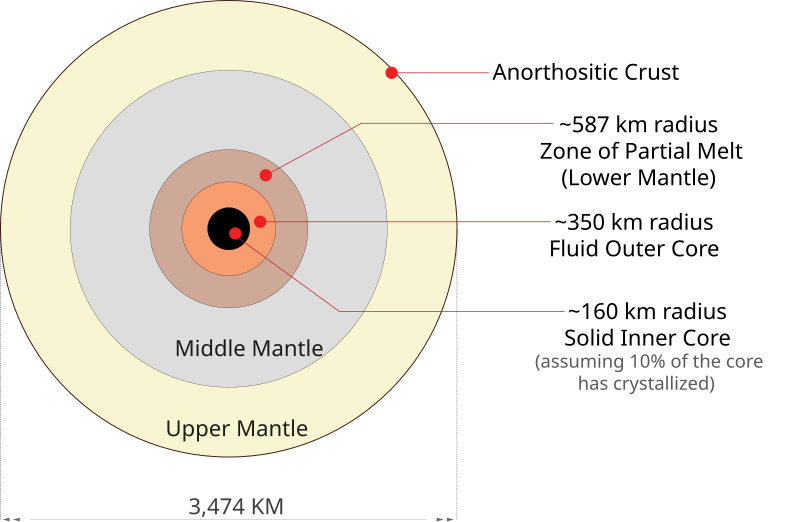
Caption: A schematic cross section of a model of the interior of the Moon.
A few initial comments must be made.
First, remember that the our knowledge of internal structure of the Moon is imperfect and subject to future correction.
Second, the model of internal structure of the Moon is much less certain than that of the Earth.
Third, the diagram to the right is already slightly out of date and the values for the layers have been revised a bit. Qualitatively it is adequate.
The layers of the Moon (which are depicted in the diagram) are:
Image link: Wikipedia: File:Moon Schematic Cross Section.svg.
- So Much for ... :
So much for a description of the interior of the Moon.
- The first class of
moonquakes are correlated with the
anomalistic month
(the time from
apogee to
apogee or
perigee to
perigee).
Most of these
occur when the Moon is at
perigee
and apogee.
These moonquakes
are probably caused by the Earth's
tidal force flexing the
Moon.
As far a direction observation goes, note that on the Earth, we have dug a few kilometers down, but on the Moon, no more than a few feet by the someone among the Apollo astronauts, I think???.
-
How did the Moon form?
What is the origin of the Moon?
- Three Old Discarded Theories:
There are 3 old discarded theories:
- Co-Accretion Theory:
The Moon formed at the same time as the Earth as a separate accretion out of circumplanetary disk. Formation from circumplanetary disk is believed to be origin of at least the larger members of the Jupiter system of moons, Saturn system of moons, and Uranus system of moons (see Wikipedia: Moons of Jupiter: Origin and evolution; Wikipedia: Titan: Formation; Wikipedia: Protoplanetary disk: Planetary system).
Problems: Why does the Moon then NOT have the same composition as the Earth? Why does it have a relative lack iron? Why isn't its orbit in equatorial plane of the Earth where a circumplanetary disk would tend to form.
- Fission Theory:
The early Earth spun so fast that a part of the mantle broke off after chemical differentiation had occurred. This explains why the Moon surface material has an elemental composition similar to the Earth's mantle and why the Moon has relatively little iron.
Problems: Why was the early Earth spinning so fast? Why is the Moon orbit NOT in the equatorial plane of the Earth where a fission would tend to put it? The Moon orbit is much closer to being in the ecliptic plane.
- Capture Theory:
The Moon was formed elsewhere in the Solar System and captured by the Earth.
Problems: Capture demands very improbable initial conditions to occur according to celestial mechanics. The theory still doesn't explain why the Moon material is like Earth's mantle, but has a relative lack of iron.
- Giant Impact Hypothesis:
The problems with the old theories led to the giant impact hypothesis in the which is nowadays considered the overwhelmingly strong favorite. See the artist's conception of the giant impact in the figure below.

Caption: "Artist's depiction of the impact of a body the size of the Moon impacting a planet the size of Mercury."
Something like this happened to the Earth some millions to hundreds of millions of years after its formation in the giant impact hypothesis of the origin of the Moon.
This looks like a head-on impact---in the giant impact hypothesis the impact is thought to be glancing.
Credit/Permission: NASA, 2009 (uploaded to by User:Serendipodous, 2010) / Public domain.
Image link: Wikipedia: File:Artist's concept of collision at HD 172555.jpg.
The giant impact hypothesis was first introduced as a undeveloped theory in 1946. In the mid-1970s, the theory was revived and developed and quickly became the accepted theory of the origin of the Moon (see Giant impact hypothesis: History of model) and the figure below.
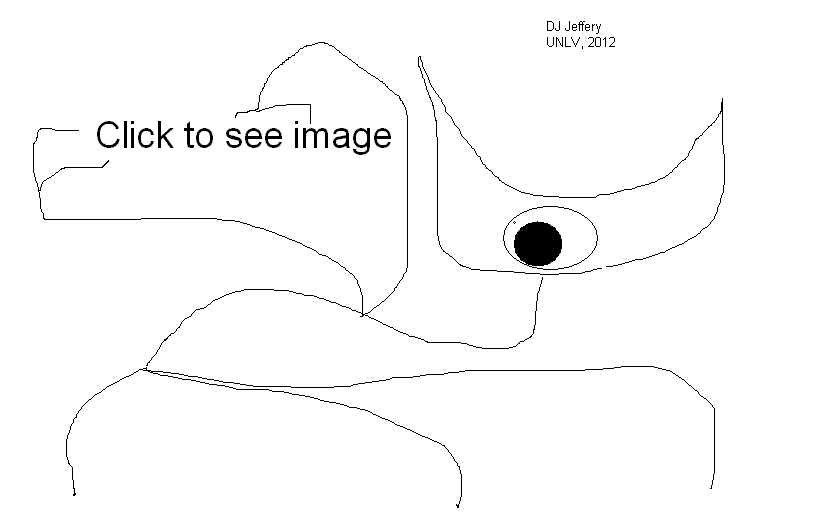
Caption: Al Cameron (1925--2005) (AKA Alastair G. W. Cameron). See also Wikipedia: Alastair G. W. Cameron (1925--2005).
Al Cameron was one of the pioneers of the giant impact hypothesis in the 1970s.
The image from circa 1975??? was long before I occasionally crossed paths with Al in the 1980s and 1990s at the University of Oklahoma and Harvard College Observatory.
A sad fact of getting older, all the great ones pass away---and only us poor epigones are left to carry on.
Credit/Permission: The Harvard Gazette: Alastair Graham Walter Cameron, 2009, image circa 1975??? / None: You will have to click on image to see Al.
Image link: Itself.
Image link: Placeholder image alien_click_to_see_image.html.
The essence of the giant impact hypothesis is explained in the figure below (local link / general link: moon_formation.html).
- Where Did Theia Come From?
Where did the hypothetical giant impactor---now usually called Theia---come from?
One idea that has gained some traction is Lagrangian point theory which is illustrated by the animation in the figure below (local link / general link: moon_theia.html).
- EOF
- So Much for ... :
So much for the origin of the Moon.
Now let us evolve the Moon.
- Co-Accretion Theory:
-
After accretion phase (assuming the giant impact hypothesis
is valid), the Moon was still very hot.
- They sunk into the Moon and were never seen again.
- They became the maria.
- They became the green cheese.
It also contained radioactive isotopes that further heated the interior.
Some chemical differentiation must have occurred creating a small iron-rich core.
In the period from about 4.6 to 3.8 Gyr ago, the heavy bombardment occurred.
The Moon was heavily cratered. Most of the large craters we see today date from the heavy bombardment.
There was cratering on cratering fragmenting the lunar crust (Se-453).
There were a few very large impactors that created giant lunar basins which are impact craters greater than about 200 km in average diameter.
Mostly in the period from about 3.5 to 3 Gyr ago, massive lava flows that flooded the giant basins on the Moon to create the lunar maria.
Some maria are older than 4.2 Gyr and some seem to be as young as 1.2 Gyr (see Wikipedia: Lunar mare: Ages).
The lunar maria are usually in giant impact basins created by giant impactors. It may be that in many cases, the giant impactors weakened the lunar crust and initiated the massive lava flows, but this theory is still being debated circa 2021 (see Wikipedia: Lunar mare: Distribution of mare basalts).
A theory for some lunar maria, in particular Oceanus Procellarum, is that they formed from lava flows from resembling rift valleys (see Wikipedia: Oceanus Procellarum: Origin; Gibney, E. 2014, Nature, Oct01, Moon's largest plain is not an impact crater), and NOT in giant impact basins. This theory is still being debated.
The internal heat that caused the flooding was increasingly depleted and the flooding turned off.
-
Question: What became of the lava-flooded
giant basins?
Answer 2 is right.
But aside from the giant lava flows, here was much less volcanism on the Moon than on Earth.
The unflooded, lunar highlands were never erased by volcanism: they only continued to suffer impacts at decreasing rate.
The maria are sufficiently younger than the highlands that they missed the heavy bombardment or most of it.
Most lunar maria probably formed more than 3 Gyr ago though some regions may be as young as 1.2 Gyr (see Wikipedia: Lunar maria: Ages).
Hence the maria are much less cratered than the highlands.
Now for some exciting Moon evolution videos, see Moon formation and evolution videos below (local link / general link: moon_formation_evolution_videos.html).
-
After the maria stopped forming, the evolution of the
Moon has
been very slow.
There are some moonquakes from the Earth's tidal force and from impacts as mentioned above.
These can cause occasional landslides.
The daily heating and cooling of rocks causes expansion and contraction can cause fracturing at a slow rate.
But the main ongoing geological activity is continuing meteoritic impacts---at a much slower rate than in the heavy bombardment, of course. Thus, the Moon has impact geology.
The continuing bombardment has made a few recent large craters: e.g., Crater Tycho: see the figure below. (local link / general link: moon_map_composition_false_color.html).
The continuing bombardment has also continuously fractured, fragmented,
and blasted the surface.
The blasting has been by the steady impacting
meteoroids, particularly
of micrometeoroids
(see Wikipedia: Regolith: Moon).
The blasting process is called meteoritc weathering
which is a special case of
space weathering.
See the figure below
(local link /
general link: space_weathering.html).
Space weathering
causes the surface of the Moon to be mostly covered by
regolith.
The regolith is a heterogeneous mixture rock fragments, pebbles, dust that reach maybe 3 to 30 meters in depth (HI-142).
Only about 1 % of the regolith is meteoritic---most of it is fragmented lunar rock (Se-452).
The uppermost few meters of regolith is mostly fine, glassy, slippery dust called lunar soil (Ze2002-177; HI-142).
-
Glass is mostly silica (SiO_2) like rock, but it does NOT
have a crystalline structure. It has an
amorphous structure. The atoms are arranged randomly.
Glass is created by quick cooling of molten silicates.
Small, lumps of molten or vapor silicate ejecta from an impact site are likely to cool very rapidly and become small glassy spheres or spheroids (Ze2002-177).
The glassy dust is slippery because it acts like tiny ball bearings it seems (see Popular Science, 1972, December, p. 64, Last Apollo Will Put First Scientest on the Moon; Wikipedia: Lunar Soil: Mineralogy and composition).

Caption: "This image is a flatbed scan from the book Recreations in Astronomy by H. D. Warren D.D., published in 1879. The figure was named "Lunar Day", and it represents a historical concept of the lunar surface appearance. Robotic missions to the Moon later demonstrated that the surface features are much more rounded due to a long history of impacts."
Some of Warren's geological features look like rough stalagmites, but how the features would have formed on the Moon is unclear.
Credit/Permission: H. D. Warren D.D.
or associated artist,
1879
(uploaded to Wikipedia
by User:RJHall,
2004) /
Public domain.
Image link: Wikipedia:
File:Old view moon.jpg.
This old idea of the lunar surface is mostly wrong.
To reiterate, Space weathering and fragmenting intermittantly by large impactors over billions of years has reduced it mostly to regolith.
In most places at least, the lunar surface is smooth and powdery and slippery as illustrated in the figure below (local link / general link: moon_regolith_pete_conrad.html).
Note, this is a color picture, but the Moon is
NOT colored: it's black, white, and shades of gray mostly.
Notice the regolith dust. This powdery dust has been
created by bombardment by micrometeoroids.
The dust (NOT the
regolith
in toto) is perhaps a few centimeters thick
(Se-445.)
The dust is quite glassy and slippery
(Ze2002-177).
The Apollo astronauts
always landed in the daytime, but the sky looks black
because there is no atmosphere to scattering sunlight around.
Recall the lunar day is as long as the lunar month (29.53059 days
on average), and so lunar daytime is about 14.7 days.
Because of the Moon's small size the horizon seems very near.
Perhaps this is NOT obvious in images, but the
Apollo astronauts
were quite struck by it
(PF-103).
Credit/Permission: NASA,
NASA: Great Images in NASA: Lunarama,
1972 /
Public domain.
Most arid terrain on Earth still
shows water run-off features.
On the Moon,
there are NO
gullies
or water
channels.
There has been no flowing
water for gigayears and maybe never.
See Gwendolyn D. Bart, 2007,
Icarus, April,
Comparison of Small Lunar Landslides and Martian Gullies.
Gwen Bart is an old friend of yours truly at
University of Idaho (UI).
Form groups of 2 or 3---NOT more---and tackle
Homework 12
problems 4--10 on the Moon.
Discuss each problem and come to a group answer.
Oh, 5--10 minutes.
See Solutions 12.
The winners get chocolates.
There are, of course, larger rocks and even boulders around.
See the figure below.
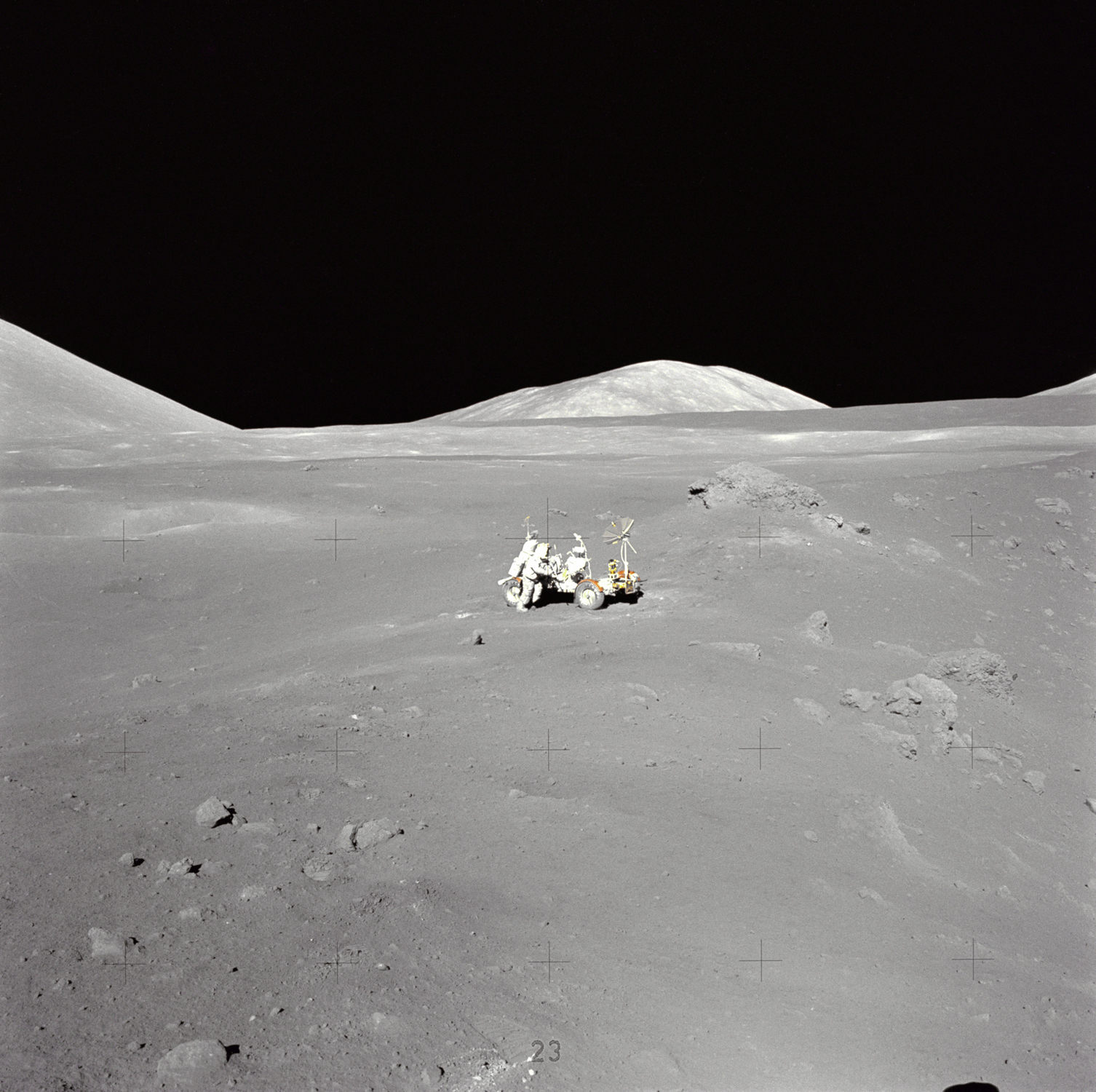 Caption: Jack Schmitt (1935--)
of Apollo 17
1972 Dec12,
his dune buggy
(AKA the Lunar Roving Vehicle),
regolith, and
Shorty Crater's edge at
the right.
Caption: Jack Schmitt (1935--)
of Apollo 17
1972 Dec12,
his dune buggy
(AKA the Lunar Roving Vehicle),
regolith, and
Shorty Crater's edge at
the right.
Image link: Itself.
Question: What is different about the lunar
terrain compared to arid
terrain on Earth such as in the American south-west?
Answer 3 is right.
Actually, there are small gully-like features on the Moon, but they are NOT
caused by water flow.
A dry flow of lunar soil can cause them.
I don't think the Moon looks ochre. Sort of grey mostly.
Ochre is the color pale-yellow to orange or reddish in hue or
pigments of this color made of a mixture of hydrated iron oxide
and earthy materials
(Ba-838).
Group Activity:
-
What are the lunar mountains?
- Eroded Crater Rim Mountains:
Most of what we identify as lunar mountains are eroded large crater rims.
Smaller impactors subsequent to the larger impactors that created the crater rims break the crater rims into lunar mountains.
The giant impact craters (AKA basins) that flooded to become at least most of the maria are rimmed by the most obvious lunar mountains of the eroded crater rim kind.
The eroded crater-rim lunar mountains form lunar mountain ranges.
The figure below shows what is probably an eroded crater-rim lunar mountains---it would take an expert to know.

Caption: Montes Recti is a small, isolated lunar mountain range on the near side of the Moon in the northern part of Mare Imbrium a bit west of Crater Plato.
It rather a straight east-west mountain range, about 90 km long and about 20 km wide and has peaks rising to 1.8 km above the something---some mean lunar radius or the Mare Imbrium level???.
Just guessing, Montes Recti may been part of a very large crater rim. The rest of the crater rim may been eroded away then covered by the lava flow that created Mare Imbrium.
Because it is isolated in Mare Imbrium and near the fairly obvious Crater Plato, Montes Recti may be marginally observable with a small optical telescope.
Credit/Permission: © Abhijit Juveka (AKA User:Velasoraptor), 2013 / Creative Commons CC BY-SA 3.0.
Image link: Wikipedia: File:Montes Recti.jpg.
- Rift Crinkles:
A hypothesis from 2014 is that some of the lunar mountain ranges attributed to eroded crater rims around giant impact craters are NOT that.
Instead as the Moon cooled some pieces of surface contracted unevenly and rifts formed between some of the pieces. Near the rifts, the surface crinkled like drying mud and the crinkles became lunar mountain ranges---that then suffered erosion by subsequent impactors.
A contracted piece itself may have been covered by later lava flow and became some of the lunar maria.
The contracted piece are in some respects like tectonic plates on Earth---but they arn't and there is no evidence that plate tectonics has ever occurred on the Moon.
Let us call the scenario just sketched the lunar rifting process (see Gibney, E. 2014, Nature, Oct01, Moon's largest plain is not an impact crater).
The largest region of maria (which includes the Oceanus Procellarum, the largest mare) may have formed at least in part by the lunar rifting process as mentioned above (see Wikipedia: Oceanus Procellarum: Origin; Gibney, E. 2014, Nature, Oct01, Moon's largest plain is not an impact crater).
But Oceanus Procellarum is the only region for which the lunar rifting process has been invoked so far.
The evidence for the lunar rifting process is from gravimetric measurements by the GRAIL mission.
Time will tell if the lunar rifting process theory remains viable.
- Crater Rim Mountains:
Large, not-heavily-uneroded crater rims can be regarded as circular lunar mountains.
As an example, see Crater Copernicus in the figure below (local link / general link: mare_imbrium.html).
- Central Peaks of Central-Peak Craters:
The central peaks of central-peak craters form isolated lunar mountains.
Although, the vague suggestion that central peaks form from the rebound of impactors sounds plausible, there is, in fact, NO established theory of their formation (Wikipedia: Complex crater: When central peaks form).
- Volcanoes on the Moon: Lunar Domes:
There are a few volcanoes on the Moon.
But they are a small proportion of all lunar mountains and are NOT obvious at first examination of lunar imagery.
The volcanoes are called lunar domes and are a form of shield volcano.
They are probably all extinct and probably have been so at least 1 Gyr ???? since the youngest lunar maria are from 1.2 Gyr BP (see Wikipedia: Lunar mare: Ages). The youngest lunar maria are an indication of the last lava flows to the lunar surface.
Lunar volcanoes are a very subordinate feature of the present-day Moon.
There may be many more in the early days of the Moon but they probably have been largely erased by impact geology.
The figure below shows some lunar domes.
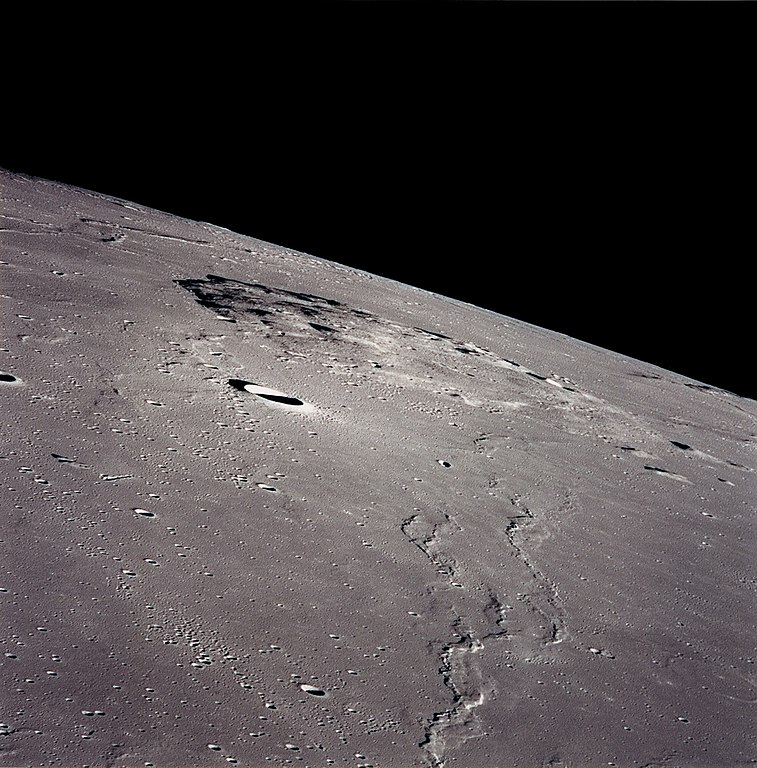
Caption: Mons Ruemker in the Oceanus Procellarum imaged by Apollo 15 in 1971.
Mons Ruemker is a large volcanic formation. Just guessing, it could be a volcanic plateau similar to the Tharsis region on Mars.
Mons Ruemker is mound-like with a diameter of about 70 km and rises to about 1.1 km above the surrounding plain.
On it, there are about 30 lunar domes which are a kind of shield volcano.
Perhaps, Mons Ruemker is essentially the combination of the lunar domes.
Credit/Permission: NASA, 1971 (uploaded to Wikipedia 2005) / Public domain.
Image link: Wikipedia: File:Mons Ruemker Apollo 15.jpg.
There are also irregular mare patches which relativly small round mounds. They are found in lunar maria and are typically of order 500 m wide. It has been suggested that they originate in lava flows that only a few tens of millions years old (see Wikipedia: Irregular mare patch: Origin). That there could be lava flows as young as a few tens of millions years is debated.
- Lunar Lobate Scarps:
Lunar lobate scarps: relatively small ridges extending only a few miles with heights up to 100 m.
Stretching a point, one might call them lunar mountains. But probably most people would NOT call them lunar mountains.
The lunar lobate scarps seem to have formed within the last few hundred million years.
As the lunar interior cools and contracts a little??? over geologic time, the Moon, and consequently the rigid lunar surface cracks and buckles to form the lunar lobate scarps.
Mercury has similar, but much larger, Mercurian lobate scarps.
- Rift Crinkles:
-
They are NOT the
Mountains of the Moon.
See the figure below.

Caption: "Plants in the Bujuku Valley, Rwenzori Mountains National Park, in the Rwenzori Mountains (AKA the Mountains of the Moon) at about 3,700 m altitude, SW Uganda, Africa." (Slightly edited.)
The Rwenzori Mountains have been identified, probably NOT correctly, with the legendary Mountains of the Moon---the legendary source of the Nile.
The Rwenzori Mountains are exotic---but they are of this world.
Credit/Permission: ©
Manuel Werner (AKA User:Werner,_Deutschland),
before or circa 2006
(uploaded to
Wikimedia Commons
by User:Nup,
2006) /
CC BY-SA 2.5.
Image link: Wikimedia Commons:
File:Ruwenpflanzen.jpg.
We adopt the rather broad and vague definition of anything that rises high above the surroundings, and thus include some features that some people would omit.
The following is our list:
Such mountains may never have existed on the Moon or they may have been totally erased by impact geology.
-
What causes lunar craters?
- The Discovery of Lunar Craters:
Yours truly doesn't think obviously recognizable lunar craters can be seen with the naked eye under any circumstances.
-
Most lunar maria are believed to have formed
in the basins of very large lunar craters
and we can see some maria with the
naked eye.
So in a sense we see some lunar craters
with the naked eye---but
we don't recognize them as lunar craters by
the naked eye.
The first telescopic maps of the Moon were made Thomas Harriot (c. 1560--1621) (see figure below: local link / general link: thomas_harriot.html) from 1609 Jul26 on.
Harriot beat Galileo Galilei (1564--1642) to the punch in making Moon maps, but he, Harriot, never published his Moon maps, and so Galileo, who published promptly in 1610, got all the credit---which is just since what good is a discovery that no one knows about.
- Lunar Crater Theories:
No one had a plausible scientific hypothesis about the nature of lunar craters until the geologists became knowledgeable about volcanic craters.
The plausible hypothesis after volcanology was sufficiently developed was that lunar craters were volcanic craters. In fact, up until the mid-20th century, most scientists thought that the lunar craters were volcanic craters (FMW-173).
We know now that they are all or almost all impact craters.
Why were the lunar craters thought to be VOLCANIC?
Well most CRATERS on Earth are volcanic craters after all.
But lunar craters are, in fact, rather different from volcanic craters.
In contrast to volcanic craters, lunar craters:
- are NOT on top of mountains.
- can be very large.
- have wide rims compared to their bases.
- tend to have interiors below the surrounding plain.
We will now compare a volcanic crater and an impact crater:
- First, a volcanic crater
in the figure below.
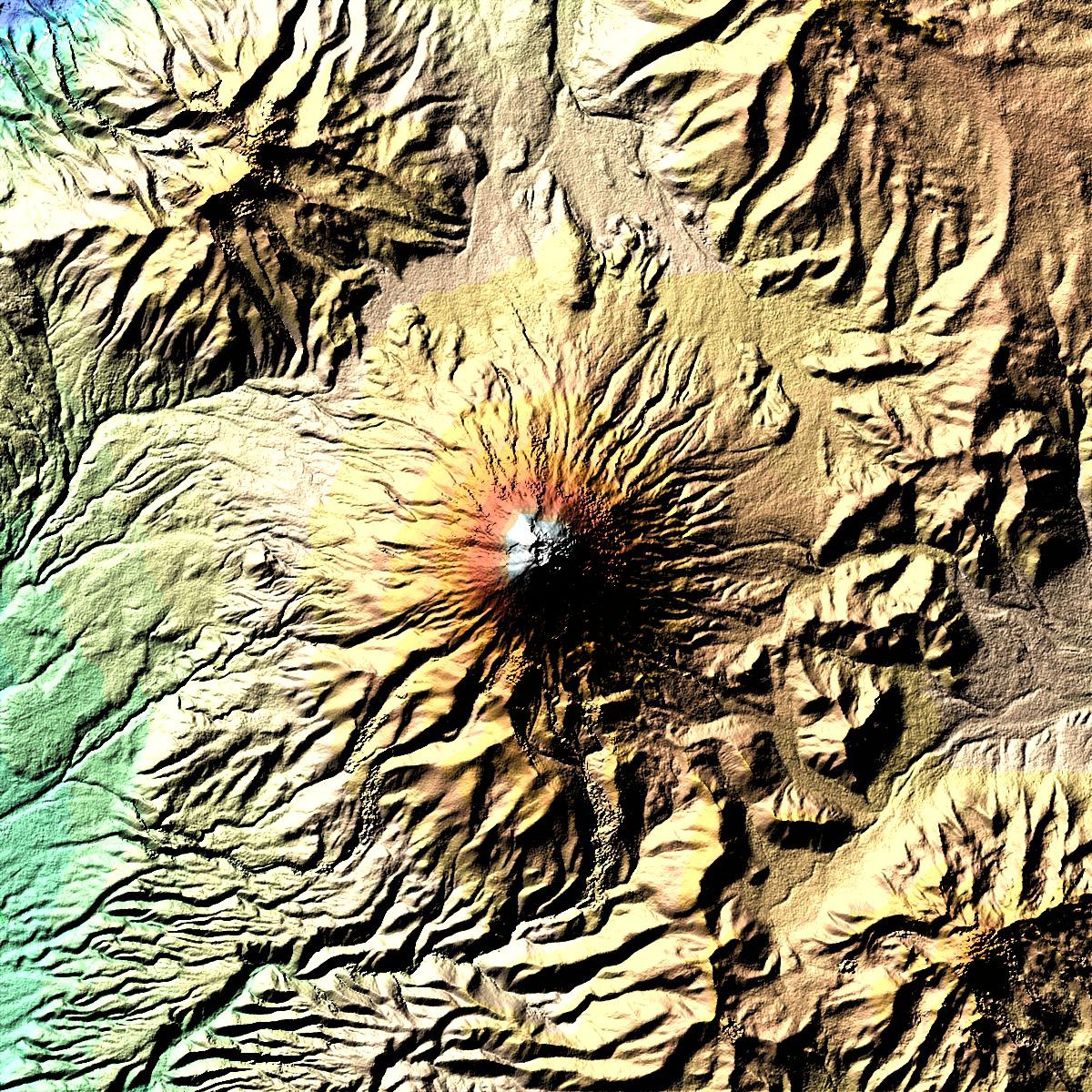
Caption: Mt. Cotopaxi is a stratovolcano in the Andes 28 km south of Quito, Ecuador, South America.
This is NOT an image. It is false color constructed model.
Mt. Cotopaxi is the highest active volcano. It rises to 5897 meters above sea level and is more than 3000 meters higher than the surroundings.
It's base is about 23 km. The outer volcanic craters at the top is 800 X 650 meters.
Mt. Cotopaxi is a dangerous active volcano.
Credit/Permission: NASA, 2000 / Public domain.
Download site: NASA: STS-99 Shuttle Mission Imagery. Alas, a dead link.
Image link: Itself.
- Next, a typical largish impact crater in the figure below (local link / general link: crater_keeler.html).
So why were lunar craters (which are impact craters) thought to be volcanic for so long by most scientists (i.e., until the mid-20th century: (FMW-173)?
There was a major obstacle to the idea of IMPACT CRATERING being common on the Moon.
-
Question: The seeming obstacle was:
Answer 2 is right.Surely impact craters should usually have odd shapes depending on the ANGLE OF IMPACT. When you throw a stone in a sandbox if it hits obliquely it creates grooved path.
But almost all the lunar craters are ROUND.
But modern computer modeling and experiments have resolved the ROUNDNESS PROBLEM.
The essential distinction of space impactors from stones in sandboxes is the high speed of impactors.
This high speed means huge kinetic energy, much of which becomes heat energy on impact. Becoming heat energy on impact is no distinction from the sandbox case, but the amount of heat energy is explosive for large impactors. By explosive, we mean the hot vapor exerts strong pressure forces. The explosions strongly tend to be azimuthally symmetric about the point at some depth in the impact site.
-
Note, momentum is conserved.
The impactor momentum gets deposited to the Moon as a whole and that hardly moves the Moon---unless the impactor is giant impactor---but there have been none of those since the heavy bombardment.
The explosion momentum is small since the explosion is nearly isotropic. Individual bits of ejecta from the explosion have high momentum, but momentum is vector and the isotropy leads to cancellation.
Note also, impactor energy grows relative to momentum magnitude with impactor speed since KE/p=(1/2)mv**2/(mv)=(1/2)v.
- The Cratering Process:
Let us look at the cratering process:
- First in cartoon in the figure below:
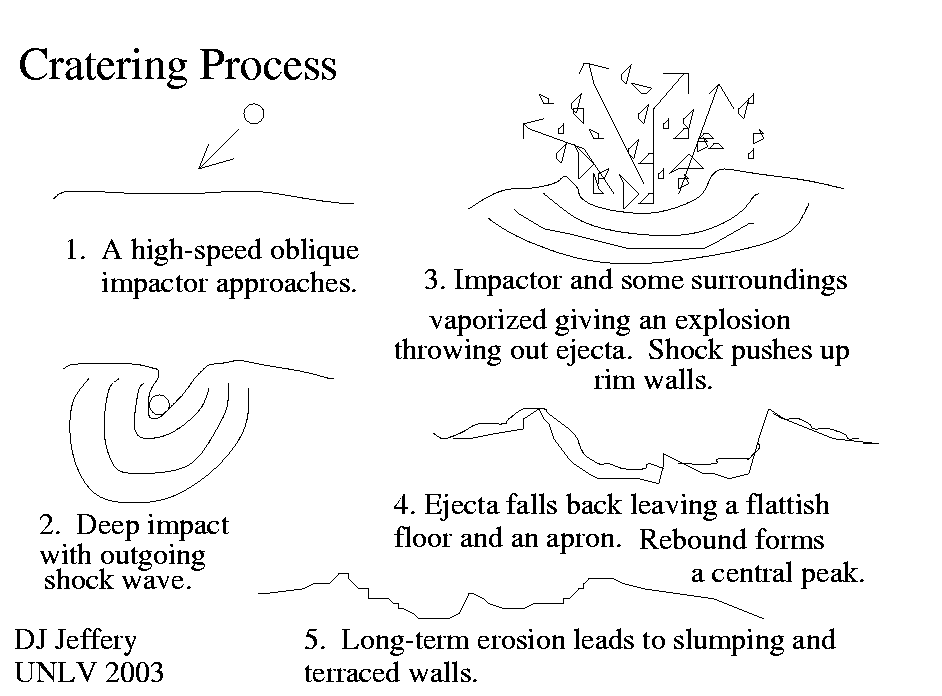
Caption: A cartoon of the cratering process.
The cratering process illustrated here is for relatively impact crater on the Moon or other airless astro-bodies.
The impact crater formed is both central-peak crater and terraced crater.
Such impact crater are common on the Moon: e.g., Crater Copernicus.
Credit/Permission: © David Jeffery, 2003 / Own work. Image link: Itself.
- Then in videos:
See Impactor videos below (local link / general link: impactor_videos.html):
- EOF
- Finally in words (Se-447, FMW-174):
- The impactor hits at very high speeds.
Recall that the orbital speed of the Earth is about 30 km/s.
Any impactor in the vicinity of the Earth is in an orbit with a speed of order 30 km/s.
The relative speed on collision might be lower depending on the direction of impact, but is still likely to be of order 10 km/s. Much more for a head-on impact.
Also the Moon's gravity will accelerate the impactor by an amount up to 2.4 km/s which is the Moon's escape speed.
-
For a radial impact where v_infinity is the speed at infinity
By conservation of mechanical energy (1/2)mv_infinity**2=(1/2)mv_impact**2-GMm/r v_infinity**2=v_impact**2-2GM/r v_infinity**2=v_impact**2-v_escape**2 v_impact**2=v_infinity**2 + v_escape**2 .The impactor thus has tremendous energy. We can do a rough estimate of the KINETIC ENERGY PER KILOGRAM:
kinetic energy per kilogram = (1/2)mv**2/m = about ( 10 km/s * 10**3 m/km )**2 = 10**8 J/kg .
For comparison, a car of mass 1000 kg moving at 50 m/s (i.e., 112 mi/hr) has kinetic energy of only about 10**6 J altogether.
- A fast impactor creates a DEEP IMPACT.
It tends to penetrate the surface to 2 or 3 times its own diameter (FMW-174) and all its kinetic energy is turned into kinetic energy of rebounding parts of the surface and heat energy.
The momentum of the interaction is conserved.
But a large amount of the mass must act as the effective impacted object.
Compared to the impactor this mass may be close to infinity.
An infinite mass violates momentum conservation on collisions. It acts as a momentum sink and source. This is the correct limiting behavior with infinite mass objects. Really momentum is conserved, but the very massive object acquires very little velocity and in the infinite mass limit none at all.
The infinite-mass effect is at the basis of causing an oblique impactor to result in a nearly circular impact explosion.
The momentum of the impactor gets spread throughout a large region of the impactee, but the energy of the impactor results in a rather localized round explosion.
This is handwaving, but correct handwaving I think.
- The impactor and some of its surroundings are VAPORIZED
by the heat.
- The vapor is rapidly expansive (i.e., explosive)
and hurls up and out in all directions
ROUGHLY EQUALLY ejecta from the impact site.
The ejecta exceeds the impactor mass typically by a factor of 10.
Some of the impactor kinetic energy probably directly becomes rebound kinetic energy of the ejecta. Maybe a significant amount. I'm NOT sure.
- The SHOCK WAVES from the explosion compress
the surface below and around the impactor.
The shock is basically azimuthally symmetric.
- The compression downward can cause a REBOUND that forms
a central peak. This tends to happen only for bigger impactors.
- The shock way acting along the ground level pushes up the
crater RIM.
- EJECTA falls back in the crater and around it often creating
a flat crater floor and an apron of material around the rim
that may be twice the rim's diameter.
- Thus, the region excavated and shaped
by the impactor is essentially CIRCULAR.
- Bomb and shell craters on Earth are formed in a similar
fashion---they are roughly circularly symmetric explosions---and
are also essentially circular
(FMW-174).
- For large impactors, ejecta thrown far beyond
the crater rims can
create concentric rings and rays such as
for Crater Tycho as
seen in the figure
(local link /
general link: moon_map_composition_false_color.html).
- The impactor can cause moonquakes
that may initiate landslides
in older craters.
- As the craters ages, the wall
can slump from landslides
due to erosion and moonquakes
and then TERRACED WALLS are created as we see
in the image of
Crater Keeler
in the figure below
(local link /
general link: crater_keeler.html).
- Finally in words (Se-447, FMW-174):
Secondary craters caused by ejected fragments from the impactor just falling under near-surface gravity (and therefore do NOT reach very high velocities) can indeed be non-circular and have elongated shapes like stones in a sandbox ??? (HI-141).
See the probable small elongated secondary craters in the figure below (local link / general link: mare_imbrium.html). We'd need a impact crater expert to now for sure that they are secondary craters.
- The Creation of the Lunar Maria:
The GIANT IMPACTORS of the heavy bombardment (circa 4.6--3.8 Gyr ago) are believed to have created the major basins in which maria formed when lava flowed into them.
-
As mentioned above in section Mountains on the Moon,
lunar rifting process
may have created some maria (in particular the largest
mare, the
Oceanus Procellarum), the
lunar rifting process theory
has yet to become established for fully developed.
The Orientale Basin is a fairly clear example of a multi-ring crater with a small mare in the inner part. See the figure below.
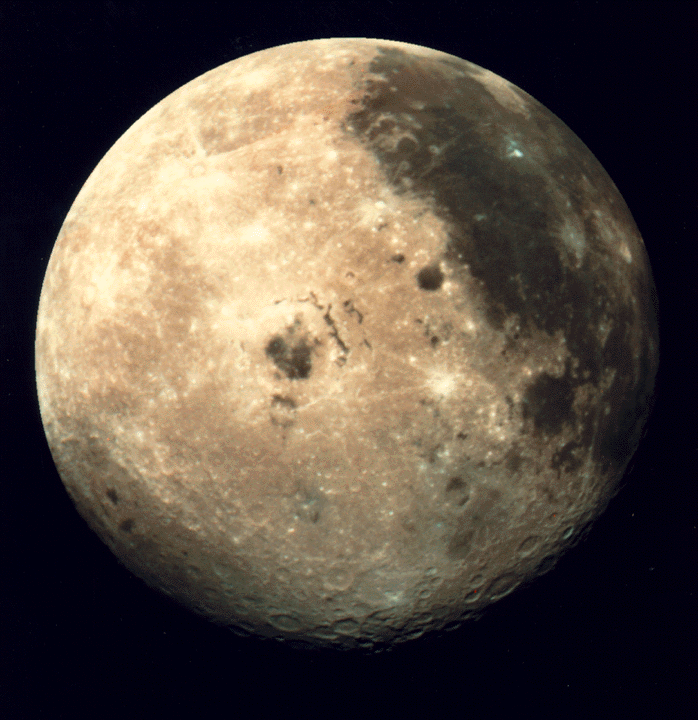
Caption: The Galileo spacecraft on its way to Jupiter produced this color image.
This image shows the western hemisphere of the Moon which is the eastern side as seen from Earth (HI-142).
The right side of the image is part of the near side. At the center is the Orientale Basin.
The Orientale Basin is a vast multi-ring basin (HI-141,143). The widest ring, which one can sort of see, is about 1000 km in diameter. Recall the Moon's equatorial diameter is only 3476 km.
The largest impactors created weak spots in the lithosphere of the Moon through which lava flowed up to create the maria: i.e., the lava plains. The Orientale Basin contains a small mare (the Mare Orientale).
The rings may have been produced by waves that froze in place (SRJ-159).
The impact probably shook the whole Moon substantially and probably created converging shock waves at the antipodal point where a jumbled weird terrain has been noticed (HI-454).
-
Weird terrain
has become the accepted name for
this jumbled landscape it seems.
Credit/Permission: NASA, 1992 / Public domain.
Download site: NASA: NASA Image ID number: P-41491.
Image link: Itself.
- Lunar Crater Theories:
Short story: impactors.
Now the long story.
-
Tidal-force geology,
space weathering,
and
occasionally large impact events
will continue to slowly evolve the Moon.
But since its surface looks much like it did 3 Gyr ago when the maria mostly stopped forming, one imagines the Moon will look much the same some gigayears in the future.
What about the Moon's orbit?
Well, the Moon is slowly spiraling away from the Earth at a current rate of 4 cm/yr (Ni-78). This is due to the tidal force of the Earth on the Moon. The rate of separation will NOT stay constant, but nevertheless gigayears in the future the Moon will be significantly farther away. In fact, calculations suggest that in ∼ 50 Gyr, the Moon will have an orbital period or ∼ 47 days, much larger than the (sidereal month (27.321661554 days: J2000)) and the Moon and Earth will be mutually tidally locked (see Wikipedia: Orbit of the Moon: Tidal evolution).
But this theoretical tidal locking will NEVER happen. The Moon will be vaporized along with the Earth in the post-main-sequence evolution of the Sun in ∼ 5 Gyr (see Wikipedia: Sun: After core hydrogen exhaustion). For the details of the Earth-Moon system doom, see file sun_red_giant.html.
"So the glory
of this world passes away:
sic transit gloria mundi."
Form groups of 2 or 3---NOT more---and tackle
Homework 12
problems 16--22 on the
giant impact hypothesis etc.
Discuss each problem and come to a group answer.
Oh, 5--10 minutes.
See Solutions 12.
The winners get chocolates.
Group Activity:
-
Mercury is in many respects similar to the
Moon.
- just flew by the object and never became gravitational bound to the object.
- went into orbit around the object.
- landed on the object.
It is a small, rocky, airless body that is heavily cratered and has lava-flow plains.
It is less well studied than the Moon.
It is much farther away and it's hard to get close-up views of it.
See Mercury in slar transit in the figure below.
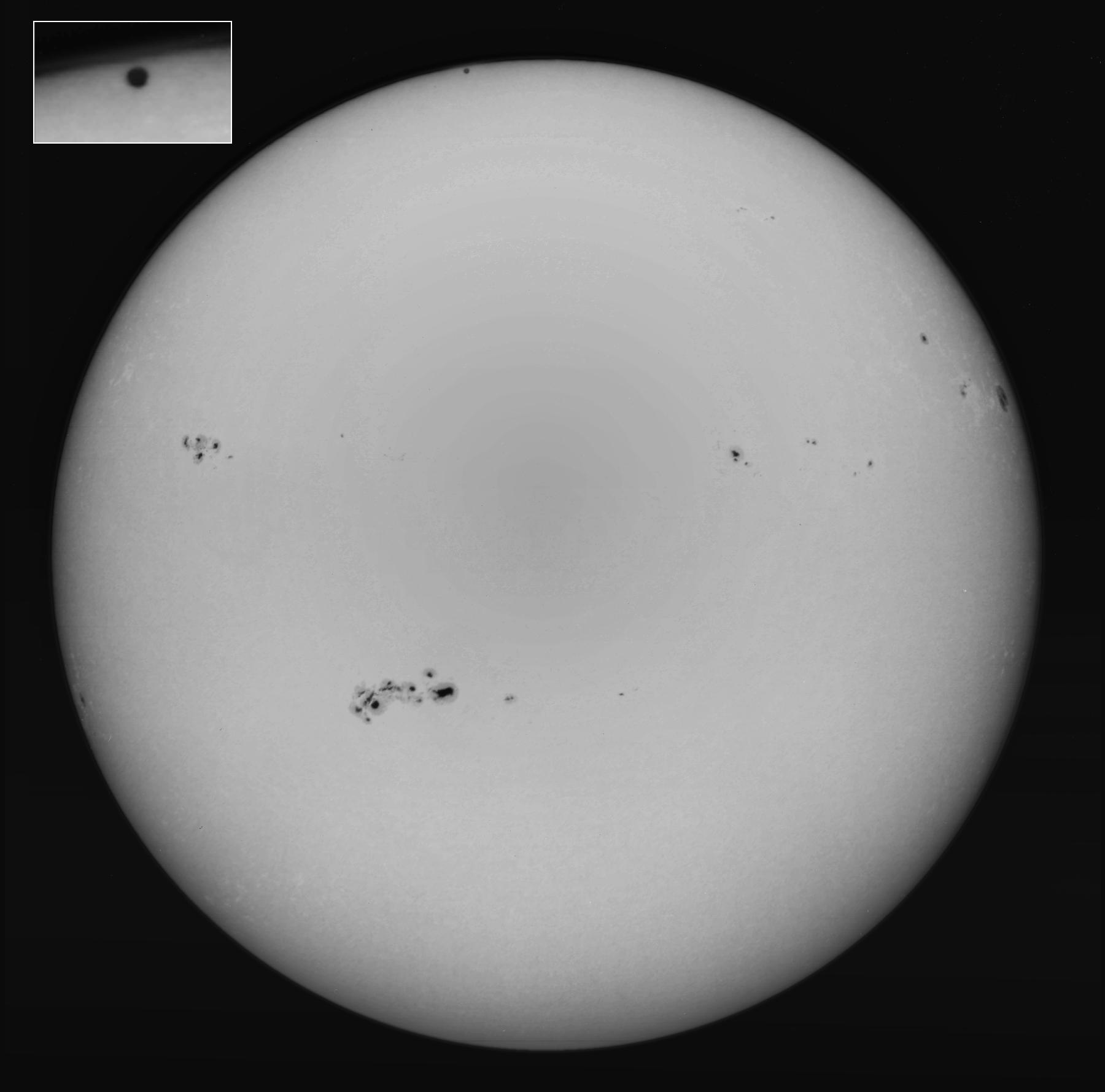
Caption: Mercury's transit of the Sun (i.e., solar transit) in 1999.
Johannes Kepler (1571--1630) missed the chance of discovering sunspots pretelescopically (but there were earlier ineffective pretelescopic discoveries going back to Gan De (4th century BCE) in 364 BCE) because he misinterpreted a sunspot for Mercury in solar transit (Ca-167).
Credit/Permission: ©
Bill Livingston, NSO/AURA/NSF,
NOAO,
AURA,
1999 /
NOAO/AURA Image Library Conditions of Use.
Download site:
Bill Livingston, NSO/AURA/NSF.
Alas, a dead link.
Image link: Itself.
In fact, until 2008 the only close-up views of Mercury came from the Mariner 10 spacecraft that did 3 flybys in the period 1973--1974.
It's NOT that Mercury is uninteresting, it's just that there always seems to be more interesting Solar System things to study.
Mariner 10 was in a heliocentric retrograde orbit (NASA: Mariner 10).
-
Question: A flyby by a spacecraft of an object means the probe:
Answer 1 is right.
Answer 2 refers to an orbiter in
space jargon.
But starting in 2008 the NASA MESSENGER spacecraft (launched 2004aug03) began giving us new close-up images and other data for Mercury and other Solar System data too.
Here's a portrait of our Solar System from MESSENGER.

Caption: "The NASA MESSENGER spacecraft has constructed the first portrait of our Solar System by combining 34 images taken by the spacecraft's Wide Angle Camera. The mosaic, pieced together over a period of a few weeks, comprises all of the planets, except for Uranus and Neptune which were too faint to detect."
This is a mosaic, NOT a snapshot.
The caption is NOT completely informative, but we may be seeing 360 degree panorama of nearly one instant in time. The panorama is curved to compress it, I'd guess. But why is it broken into pieces?
Credit/Permission: NASA,
2010
(uploaded to Wikimedia Commons
by User:User:Originalwana,
2011) /
Public domain.
Image link: Wikimedia Commons:
File:MESSENGER Solar System Family Portrait.jpg.
Initially, MESSENGER just did 3 flybys in 2008--2009, but on 2011mar18, it went into orbit around Mercury.
Here's double image of Mercury from MESSENGER.
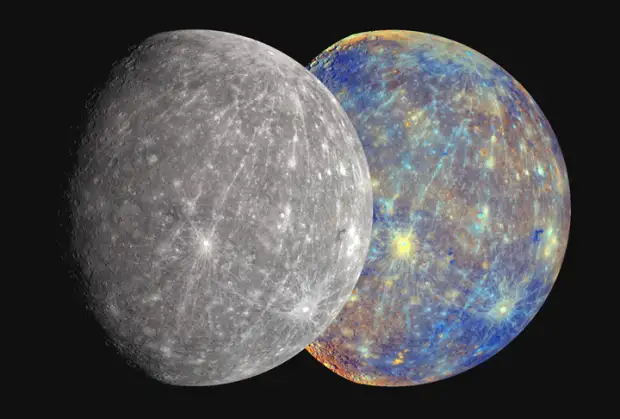
Caption: A NASA MESSENGER spacecraft image of Mercury A true colors image on the left with a false color image on the right. In true color, Mercury is just grey world. The false color image allows detailed study of features and minerals.
Mercury true and Mercury false.
Credit/Permission: NASA,
2008 /
Public domain.
Image link: NASA: MESSENGER.
Image link direct original:
285935main_img5.4.jpg.
Alas, dead link.
Image link direct:
True-Color Photos
of All the Planets in case NASA
breaks its links again. It has.
Now that MESSENGER is orbiting Mercury, we will soon know a lot more about Mercury: maybe too much for this course.
One new thing is new named impact craters. For some reason, it was decided that craters on Mercury should be named for artists of all genres and few others too. The US Geological Survey (USGS) keeps a Mercury crater list, where you can see if your favorite artist has made the cut---along with Boethius (c. 480--524 or 525) (Boethius), Katsushika Hokusai (1760--1849) (Hokusai), and Pablo Neruda (1904--1973) (Neruda).
Some new names are shown in the figure below.
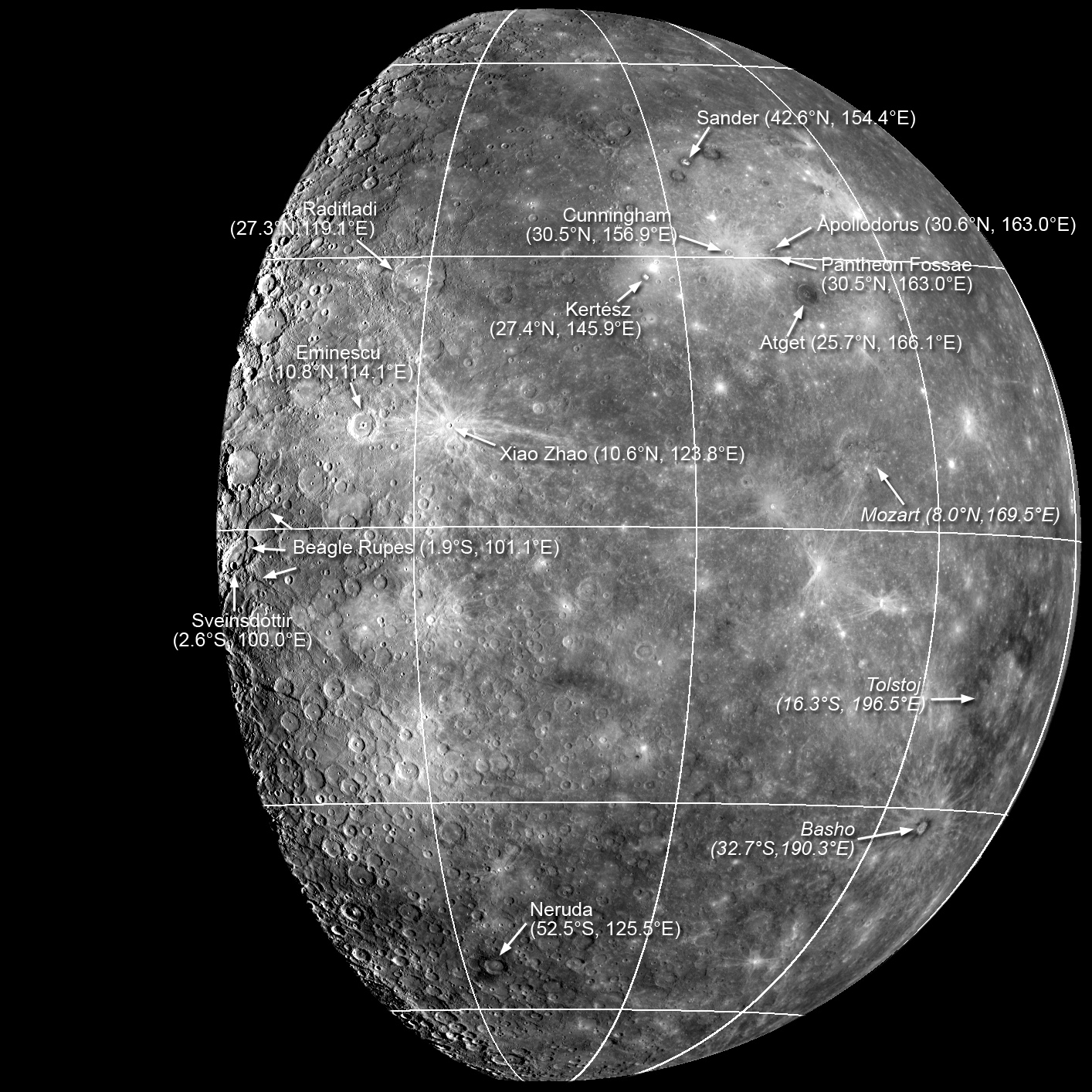
Caption: The International Astronomical Union (IAU) has approved these new names for craters on Mercury.
Pablo Neruda (1904--1973) now has his Crater Neruda.
The man himself is reading in Pablo Neruda - Poema # 20---or at least the caption claims voz e imagenes por Pablo Neruda.
Credit/Permission: NASA,
2008 Apr28 /
Public domain.
Image link: NASA: MESSENGER.
Image link direct:
new_names.jpg.
In this lecture, we will just do a quick run through on Mercury emphasizing how it differs from the Moon.
-
Just some basic Mercury facts---which, of course, beg for an explanation---and
there is some explanation, but also some "Just So".
_______________________________________________________________________________ Mercury Facts _______________________________________________________________________________ Quantity Value _______________________________________________________________________________ Mean distance from the Sun 0.387 astronomical units Eccentricity of orbit 0.2056 : Only Pluto has a larger one among the planets/ex-planets. Inclination to Ecliptic 7.00487 degrees : Again only Pluto has a larger one among the planets/ex-planets. Orbital period 87.969 days Rotational Period 58.646 days =2/3 of orbital period nearly exactly Mercurian day 175.938 days =2 of orbital period nearly exactly Equatorial radius 2439 km = 0.382 R_Earth_equatorial Mass 3.31*10**23 kg = 0.0558 Earth masses Mean density 5.44 g/cm**3 = about Mean Earth density Uncompressed mean density 5.4 g/cm**3 which is an estimate and is larger than the Earth's estimated uncompressed mean density of 4.2 g/cm**3 Surface gravity 0.38 Earth gravities Surface temperature -173 C at night to 330 C in the day The daytime high is due to the closeness to the Sun, of course. At night the surface quickly radiates infrared radiation to space and cools off. Remember space is cold. _________________________________________________________________________ Sources: Cox-294,295, Se-418, 459. _________________________________________________________________________
Mercury is NOT very large compared to the other rocky planets and it is even surpassed by two of the large moons in the Solar System---it comes in as only the 6th largest rocky/icy body---see the figure below (local link / general link: rocky_icy_body.html).
-
It was long suspected that Mercury would be
tidal locked to the
Sun:
i.e., that Mercurian year and day were the same length, and thus
Mercury always turned the same face to the
Sun.
- Tidal Locking Recapitulated:
We can recapitulate an explanation of tidal locking.
Say you have two gravitationally bound astro-bodies: a primary (whose name means the more massive of the two) and a secondary (whose (whose name means the less massive of the two).
The tidal force of primary slows/speeds up the secondary into a tidal locked state. The more massive the primary and the closer the secondary, stronger the tidal locking effect and the faster tidal locking is brought about..
The primary's tidal force stretches the secondary and then acts differentially on the tidal bulges to bring about the tidal locking of the secondary.
The secondary can also tidal lock the primary, but this takes longer. It may NOT happen at all if the secondary has to compete with other astro-bodies. The Moon is trying to tidal lock the Earth, but this will take a long time because the Earth has so much rotational inertia (i.e., resistance to rotational acceleration) and because the Sun is trying to tidal lock the Earth. The Sun's tidal locking effect is smaller and the Sun will lose out to the Moon, but it will delay the Moon's victory.
Among the planets, only ex-planet Pluto and its biggest moon Charon are mutually tidally locked (see Wikipedia: Tidal locking: Occurrence).
Tidal locking is never exactly perfect. Small perturbations keep trying to desynchonize the tidal locked astro-body. But the tidal locking effect keeps acting bring the astro-body back toward the perfectly tidal locked state.
- The Spin-Orbit Resonance:
Giovanni Schiaparelli (1835--1910) in the 1880s thought he had evidence for the tidal locking of Mercury to the Sun from observations of features he could barely discern (Se-458).
-
Schiaparelli
was the first big promoter of the
Martian canals too.
We will discuss the mythical
Martian canals in
IAL 14:
Mars: the Red Planet: Introduction: The Martian Canals.
The ratio of mean axial rotation period to mean orbital period is 2/3 to very high accuracy.
Why do we have this situation? Mercury's orbit and spin show what is called 3:2 spin-orbit resonance brought about by the tidal force of the Sun. Celestial mechanics can explain how the 3:2 spin-orbit resonance arose.
-
The varying eccentricity of
Mercury's orbit over millions
of years due to perturbation
of the other planets may cause
Mercury to get trapped in
the odd 3:2 spin-orbit resonance
(Tytell, D. 2004, Sky & Telescope, November, 22; Correia, A. C. M. 2004, Nature, June 24).
We won't go into details.
The 3:2 spin-orbit resonance means that 3 rotation periods (about 176 days) equals 2 revolution periods (about 176 days). Thus, we have the following conversion factors:
1 = 3 rotations / 2 revolutions converts revs to rots. 1 = 2 revolutions / 3 rotations converts rots to revs.
The upshot of this unusual 3:2 spin-orbit resonance is that the Mercurian day is TWICE the Mercurian year (i.e., the revolution period). The figure below (local link / general link: mercury_3_2_spin_orbit_resonance.html) explicates the Mercurian day.
- The Synodic Day Formula:
In fact, there is a formula that allows you to calculate the DAY (i.e., the synodic day) of planet given its orbital period and its axial rotational period, both relative to the observable universe, with the simplyfing assumption of uniform circular motion in a common plane. The synodic day formula is given in the figure below (local link / general link: synodic_period_day.html).
Applying the formula to Mercury gives
P_day = P_orbital*P_axial/(P_orbital - P_axial) = (2/3)*P_orbital**2/[P_orbital-(2/3)*P_orbital] = 2*P_orbital 2 * 87.9691 days = 175.9382 dayswhich is indeed approximately correct (see above local link / general link: mercury_3_2_spin_orbit_resonance.html and Wikipedia: Mercury: Spin-orbit resonance).
- EOF
- The Spin-Orbit Resonance:
Tidal locking is very common for moons in the Solar System where most significant moons are tidal locked to their parent planets (e.g., the Moon). For those moons that are NOT, see Wikipedia: Tidal locking: Occurrence: Moons. Recall we discussed tidal locking in IAL 3: The Moon: Orbit, Phases, Eclipses, and More: Lunar Rotation and Tidal Locking.
-
Unlike the Earth
and the Moon, for Mercury we have NO
seismology
and NO rocks in our hands to examine.
- The Sun's gravity pulled much of the
silicate mantle of
the early Mercury into the
Sun.
- Much of the silicate mantle evaporated and was blown away
by the solar wind.
- A giant impactor hit Mercury early on and knocked off
much of the mantle. The mantle fragments escaped and
eventually hit other bodies: e.g., Earth, the Moon,
Venus, the
Sun, etc.
NO spacecraft has ever landed on Mercury and nothing has every come back from there. MESSENGER is just an orbiter
-
It is possible that impactors on Mercury have knocked off
material that later found its way to
Earth and touched down
as a meteorite.
Meteorites from the Moon and Mars have been recognized, but
none so far as I am aware from Mercury.
-
Actually, it is a bit tricky to know the mass of a planet without
a moon. Perhaps, we know the mass from studying how Mercury perturbs
the orbits of comets, asteroids, and human-made probes.
The Earth's density is slightly larger at 5.51 g/cm**3 (Cox-240).
The Moon's density is distinctly smaller at 3.36 g/cm**3 (Se-445).
But these are densities where much of the matter is under compression due to high internal pressure.
It is possible to calculate by modeling the uncompressed densities of the rocky bodies: see the table just below.
-------------------------------------------------------------------------------------------------------
Table: Density Trends of the Rocky Bodies
-------------------------------------------------------------------------------------------------------
Body Mean Orbital Radius Mean Density Uncompressed Mean Density
(AU) (g/cm**3) (g/cm**3)
-------------------------------------------------------------------------------------------------------
Mercury 0.387098 5.4 5.3
Venus 0.723332 5.2 4.4
Earth 1.00 5.5 4.4
Moon 1.00 3.3 3.3
Mars 1.523679 3.9 3.8
Vesta 2.361 3.4 3.4
Ceres 2.7663 2.1 2.1
Pallas 2.772 2.8 2.8
-------------------------------------------------------------------------------------------------------
Note: The uncompressed densities are obtained by
modeling.
In compressed density, Mercury is the 2nd densest of the bodies in the table. And because of low gravity one does NOT expect great compression even before modeling for uncompressed density.
The conclusion that one draws is that Mercury must be richest in the densest abundant refractory: iron.
On the other hand, the surface of Mercury appears to be ordinary silicate rock. But recall no one has actually seen a sample up close.
The conclusion is that Mercury must have an IRON CORE that relative to Mercury's size is larger than the Earth's iron core.
And, of course, Mercury's iron core must be much larger than the Moon's.
The core formed through chemical differentiation when Mercury was young and hot.
We don't know how big the Mercurian IRON CORE is really, but the rocky surface may be a fairly thin layer relative to Mercury's radius (Se-459). See the cartoon illustrating the relative sizes of iron cores of Earth, Moon, and Mercury in the figure below.
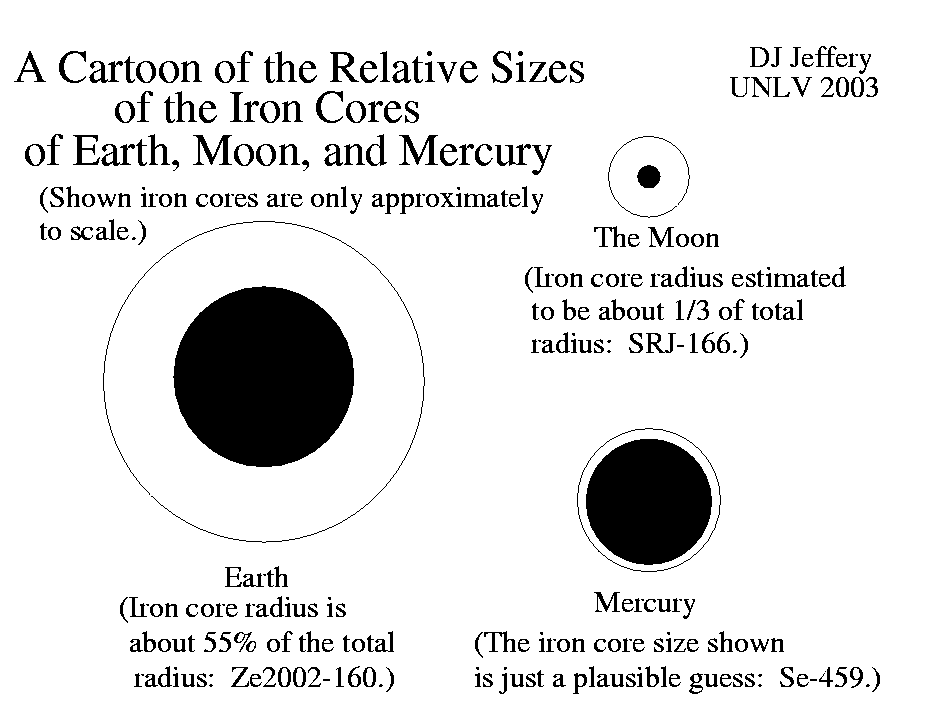
Caption: A cartoon of the relative sizes of iron cores of Earth, Moon, and Mercury (Se-459; SRJ-166 Ze2002-160).
Credit/Permission: ©
David Jeffery,
2003 / Own work.
Image link: Itself.
Why should Mercury have should a relatively large amount of iron?
Well it formed out of the primordial solar nebula closer to the Sun than the other rocky bodies.
This was hotter than the location of the Earth and a relatively smaller amount of less-refractory silicates may have condensed there than in the Earth's neighborhood.
-
Silicates
condense out at about 1200 K and iron at about 1300 K and
iron oxides at about 1500 K
(Se-418).
But the people who do the calculations think that even this temperature effect is NOT enough to explain Mercury's high iron content.
-
Question: What extra effect is invoked to explain the high
iron
content of Mercury?
Answer 3 is a viable explanation---NOT a "right" explanation note.
A giant impactor is invoked (Se-462).
(When you can't explain something invoke a giant impactor.)
It is only 0.5 % as strong as the Earth's (Se-462).
But it seems odd that there should be any significant field.
To the Mercury modelers, it seems that Mercury's core should not be molten now---it should have cooled off due to Mercury's small size (Se-462).
Mercury's magnetic field remains a bit of puzzle.
-
Mercury's SURFACE at first glance is much like the
Moon's: heavily
cratered with no current
primordial-radiogenic heat geology.
Because of its small size and lack of significant current volcanic outgassing Mercury is essentially airless just like the Moon.
The surface of Mercury is shown in the figure below.
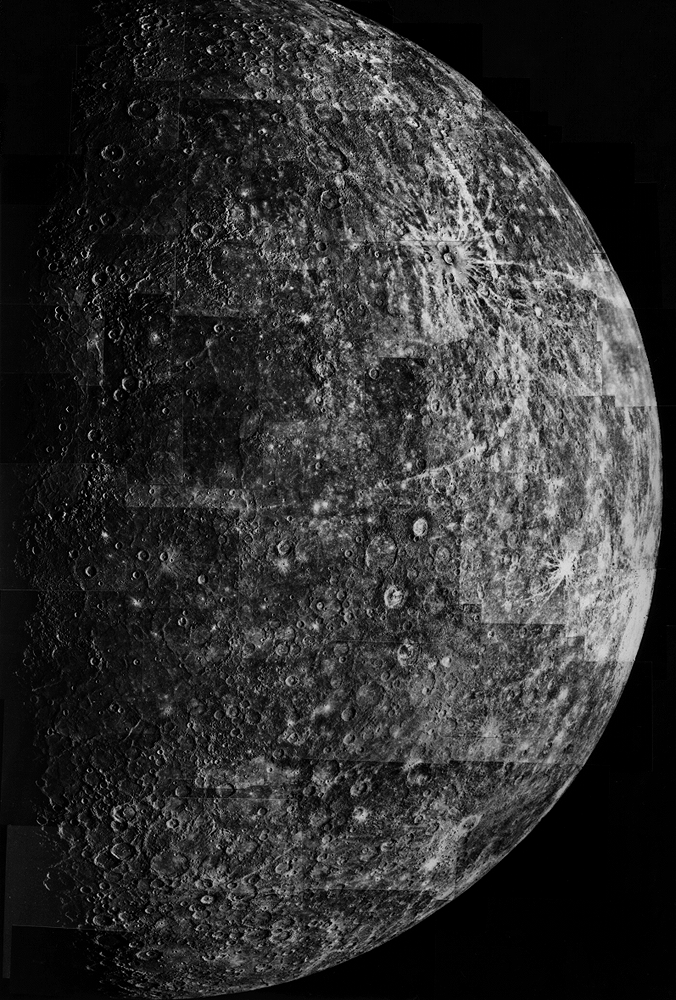
Caption: Mercury from a Mariner 10 mosaic from 1974mar30 on its 1st flyby.
The north pole is near the top and the equator is about 2/3 of the way down.
The resolution is about 2 km.
The large multi-ring basin the Caloris Basin is half visible at the terminator on the left. It is just above the middle of the image.
In the upper right is the obvious rayed Crater Degas which has a diameter of about 45 km. The rays indicate that Degas is comparatively young. By the time NASA got to Mercury, they were down to 19th century artists.
Mercury does have lava plains similar to the lunar maria, but they arn't so different in color from the other regions and so are hard to pick out.
Credit/Permission: NASA,
1974 /
Public domain.
Download site: NASA:
Global mosaic of Mercury, outgoing view: m10_aom_19.html.
Image link: Itself.
There are some differences from the Moon.
Although NOT obvious to eye, Mercury is somewhat LESS cratered than the Moon and there are relatively fewer small crater (Ze2002-179).
This distinction may be due to the Sun whose strong gravity may have affected the distribution of impactors.
But also Mercury is somewhat larger than the Moon and may have had active primordial-radiogenic heat geology for a bit longer.
Some evidence for this that lava plains on Mercury cover a larger fraction of Mercury than the lunar maria do on the Moon (HI-165).
The Mercurian lava plains similar to the lunar maria. However, they are much the same color as the rest of Mercury (i.e., gray) and so don't stand out as well as the lunar maria (Se-462).
The Mercurian lava plains can be noticed somewhat in a Mercator mosaic. See the figure below.
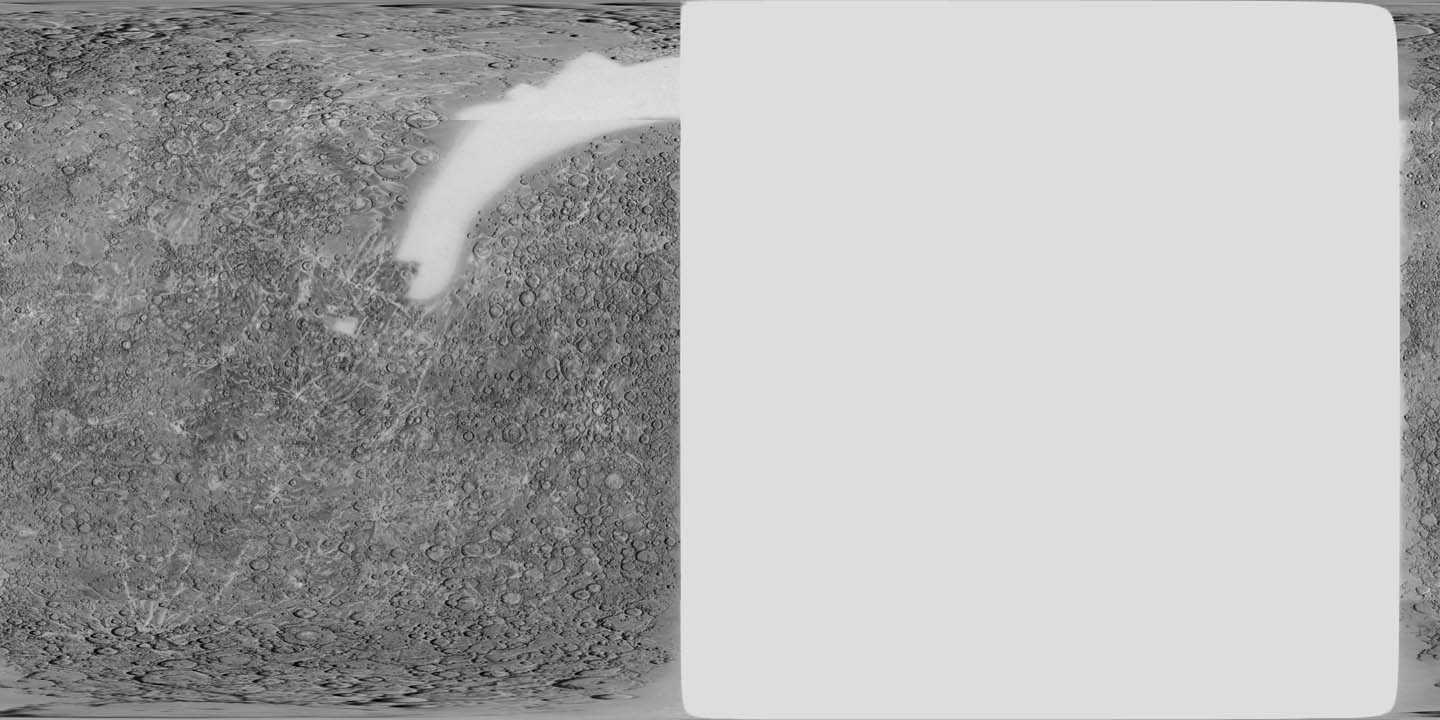
Caption: A Mercator mosaic of Mercury based on Mariner 10 images from its three 1974-1975 flybys.
Only about 50 % of Mercury was images which accounts for the blank regions. Only 10 to 180 degrees west longitude is available, but I don't know how the prime meridian is defined or why there is strip on the right.
Credit/Permission: NASA,
USGS,
2001 /
Public domain.
Download site: Views of the Solar
System by Calvin J. Hamilton:
NASA and
USGS
put the mosaic together.
Image link: Itself.
Mercury---like the Moon---shows multi-ring basins formed by giant impactors followed by lava flows.
The main example is the Caloris Basin. See the figure below.
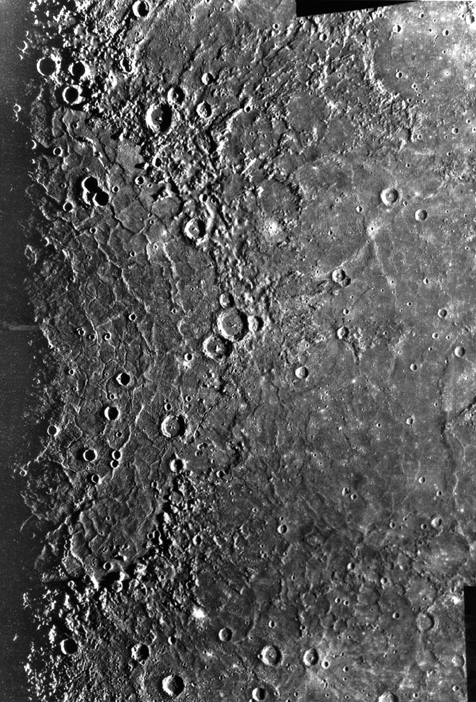
Caption: The Caloris Basin from a Mariner 10 mosaic from 1975mar16 on its 3rd and final flyby.
Unfortunately, the terminator bisects the basin. However, the long shadows do tend to emphasize contrasts in altitude.
The outermost rings are about 1300 km in diameter and the highest features are about 3 km.
The Caloris Basin is vast multi-ring basin like the Orientale Basin on the Moon (HI-141,143).
The largest impactors created weak spots in the lithosphere of bodies like Mercury and the Moon through which lava flowed up to create the maria: i.e., the lava plains. The Caloris Basin has lava filling too, but not as dark for some reason as the lunar maria.
The rings may have been produced by waves that froze in place (SRJ-159).
The impact probably shook the whole planet substantially and probably created converging shock waves at the antipodal point where a jumbled weird terrain has been noticed (HI-454).
-
weird terrain
has become the accepted name for
this jumbled landscape it seems.
Credit/Permission:
NASA,
Mariner 10 (1973--1975)
flybys
1974-1975
(Mariner 10 Mercury flybys) /
Public domain.
Download site: NASA:
m10_aom_21.html:
"This mosaic was produced with images from
all 3 flybys." (Slightly edited.)
Image link: Itself.
See the weird terrain at the antipodal point to Caloris Basin in the figure below.
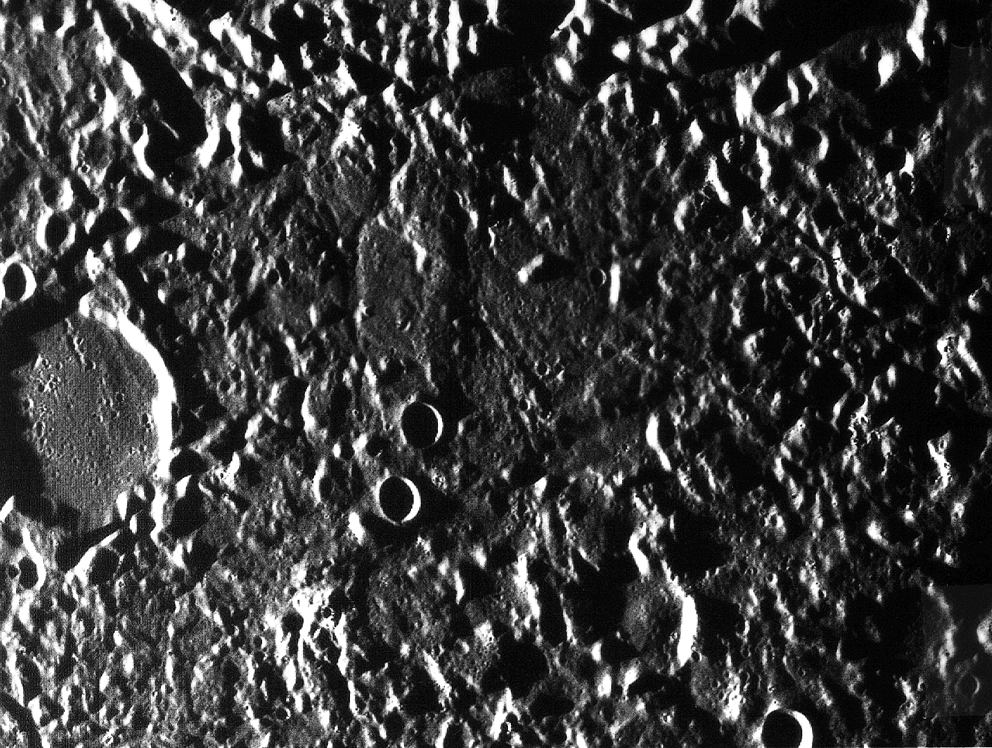
Caption: Mariner 10 image of the weird terrain antipodal to the Caloris Basin.
In the image north is up. The large, flat-floored crater at the left has a diameter of about 35 km.
To experts who have studied a lot of Mercurian landscape this region is weird terrain.
To them it looks jumbled and chaotic.
The region is antipodal to the Caloris Basin.
It is thought that seismic waves generated by the Caloris Basin impactor were focussed at the antipodal point and created the weird terrain.
Credit/Permission:
NASA,
Mariner 10 (1973--1975)
1974-1975 /
Public domain.
Download site: NASA:
m10_aom_11_20.html.
Image link: Itself.
See the figure below (local link / general link: moon_orientale_basin_formation.html) for a reminder of how weird terrain is thought to form.
One striking feature of Mercury
are lobate scarps.
-
Lobate scarps are also
found on the Moon, but there they are much smaller and much less
conspicuous.
Until 2010, there was little discussion of them and NOT much was inferred from them.
-
To be laconic about it: slow evolution caused by
tidal-force geology (due to the Sun's
tidal force),
space weathering,
and
occasionally large impact events
followed by vaporization in the
expanded solar atmosphere of the Sun in its red giant phase in
5--6 Gyr (FK-493).